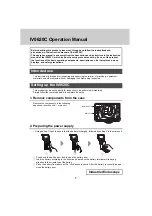
19
www.XSscuba.com
XS Scuba Inspire Regulator Service Manual
Cleaning Procedures
All reusable parts, metallic and soft, should be cleaned in a
warm (not over 120°F / 50°C) dish soap and water solution.
Use a soft, nylon bristle brush to remove any stubborn
deposits. The dish soap helps to remove grease and old
lubricant.
Plastic and Rubber Parts
After cleaning, rinse in fresh water. If your local tap water is
hard, consider using distilled water. Dry with hyper-filtered
compressed air.
Metallic Parts
WARNING: Be sure to use hand and eye
protection when handling chemical cleaning solutions.
While dish soap is an excellent degreaser, it may not remove
corrosion and mineral build up on metallic parts. That is where
acid is effective. Metal parts may be immersed in a sonic
cleaner with a diluted acetic acid (vinegar) and water solution
(50:50)
If you really want your metal parts to sparkle, consider using a
diluted solution of Oakite 31 in your sonic cleaner. Be sure to
follow the manufacturer’s instructions for dilution.
After cleaning, rinse in fresh water. If your local tap water is
hard, consider using distilled water. Dry with hyper-filtered
compressed air.
CAUTION: Never place soft parts e.g. rubber,
plastic, urethanes, silicones into any acidic solutions.
Doing so may alter their physical properties, causing
them to break, degrade prematurely or no longer fit.
NOTE: Many technicians find that a solution of
diluted dish soap and diluted vinegar in their sonic
cleaner is all they need to clean the metal parts. It is
inexpensive and very effective.
Cleaning Hoses
You may run warm soapy water (not over 120°F / 50°C)
through the regulator hose. Rinse thoroughly and then blow
hyper-filtered air through it until dry.
If the end fittings are corroded, install XS Scuba hose plugs,
p/n TL129, to seal the hose ends. The fittings may then be
briefly immersed into a diluted acidic solution in a sonic
cleaner. Again, rinse thoroughly dry.
WARNING: Do not allow any acidic solution or
other cleaning agent, other than dish soap, to enter
the inside of the hose(s). Doing so may cause a
breakdown of the inner hose lining which can lead to
obstruction of the air passage way.
Preparing and Inspecting Parts
Nitrox Preparation
If you are preparing the regulator to place back into
nitrox service (O2 not to exceed 40%), you should use
powderless latex or nitrile gloves to keep finger oils off of
the clean parts.
O-rings: All O-rings should be replaced at every servicing.
New O-rings should be inspected for contamination and/
or imperfections, and lightly dressed with a thin film of
approved lubricant prior to installation. See Recommended
Cleaner and Lubricant Table below. O-rings that surround
filters do not need to be lubricated.
CAUTION: Do not use any petroleum based
lubricants or products, or any aerosol silicone sprays
on any part of the regulator.
Diaphragm: The diaphragm should be inspected for any
holes or cuts that could allow water to enter the housing.
The best way to conduct this inspection is to stretch the
diaphragm over the end of your finger to enlarge any small
holes and make them visible. By progressively working
around the diaphragm in this manner, holes that might
have gone unnoticed can be easily located. Pay particular
attention to the area near the center plate. If the diaphragm
is damaged in any way, it should be replaced.
NOTE: Diaphragms are never lubricated.
Exhaust Valve: The exhaust valve should be closely
examined while in the main housing. Because the skirt of
the exhaust valve is very thin, it is susceptible to wear and
tears. If any imperfections are found, replace it with new.
Crown Orifice:
The critically-machined sealing edge of
the crown orifice is important to reducing sealing force.
The sealing edge must be free from nicks or scratches and
square with the centerline of the orifice. Any imperfection
can allow small amounts of air to leak between the orifice
and soft seat, and require excessive spring pressure to seal
airtight. The sealing edge of the crown orifice should be
inspected under magnification whenever possible.
It is also very important to protect the crown orifice sealing
edge during the disassembly, assembly and cleaning
operations. Normally, the crown orifice is not replaced
during service.
Содержание Inspire Regulator
Страница 6: ...6 www XSscuba com XS Scuba Inspire Regulator Service Manual ...
Страница 7: ...7 www XSscuba com XS Scuba Inspire Regulator Service Manual ...
Страница 8: ...8 www XSscuba com XS Scuba Inspire Regulator Service Manual ...
Страница 9: ...9 www XSscuba com XS Scuba Inspire Regulator Service Manual ...
















































